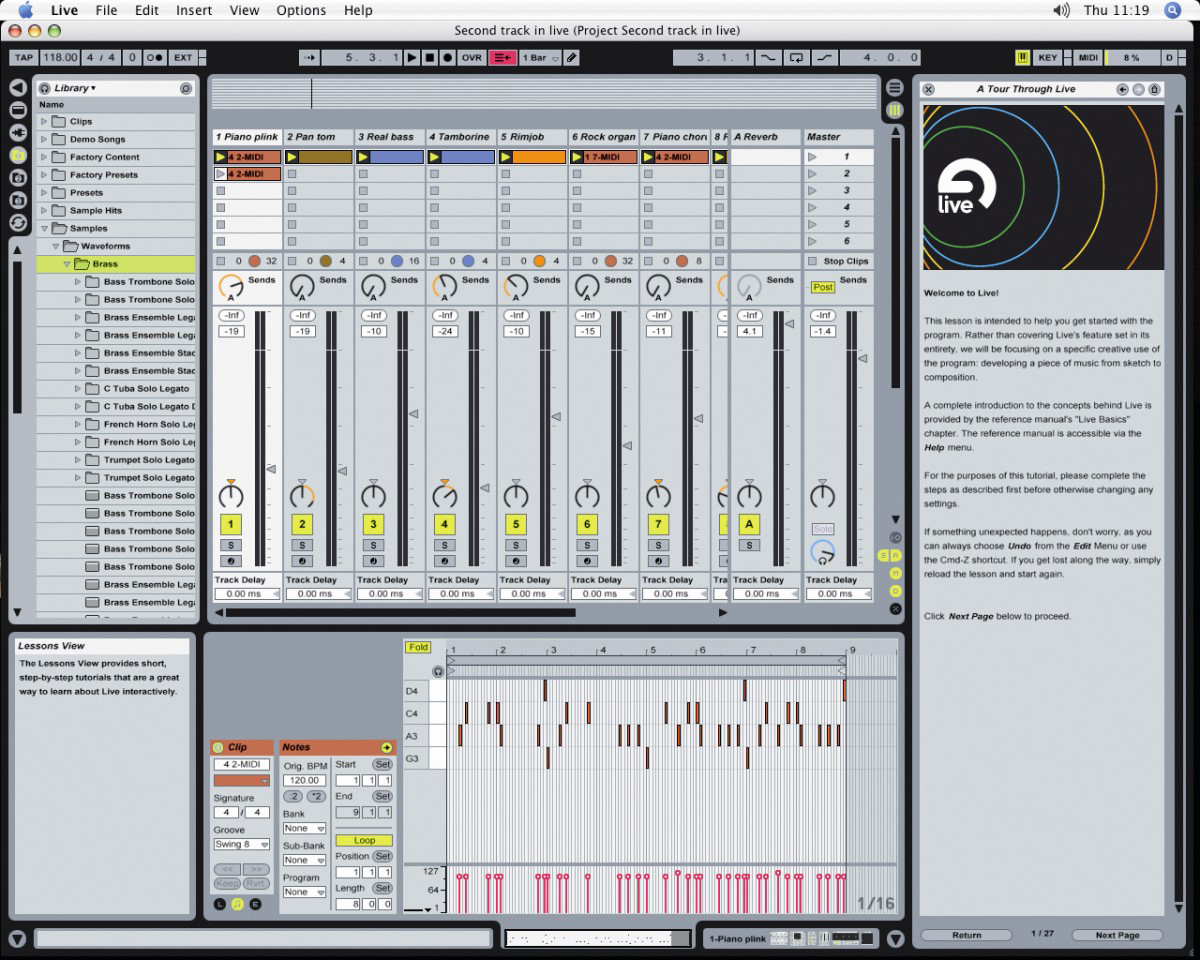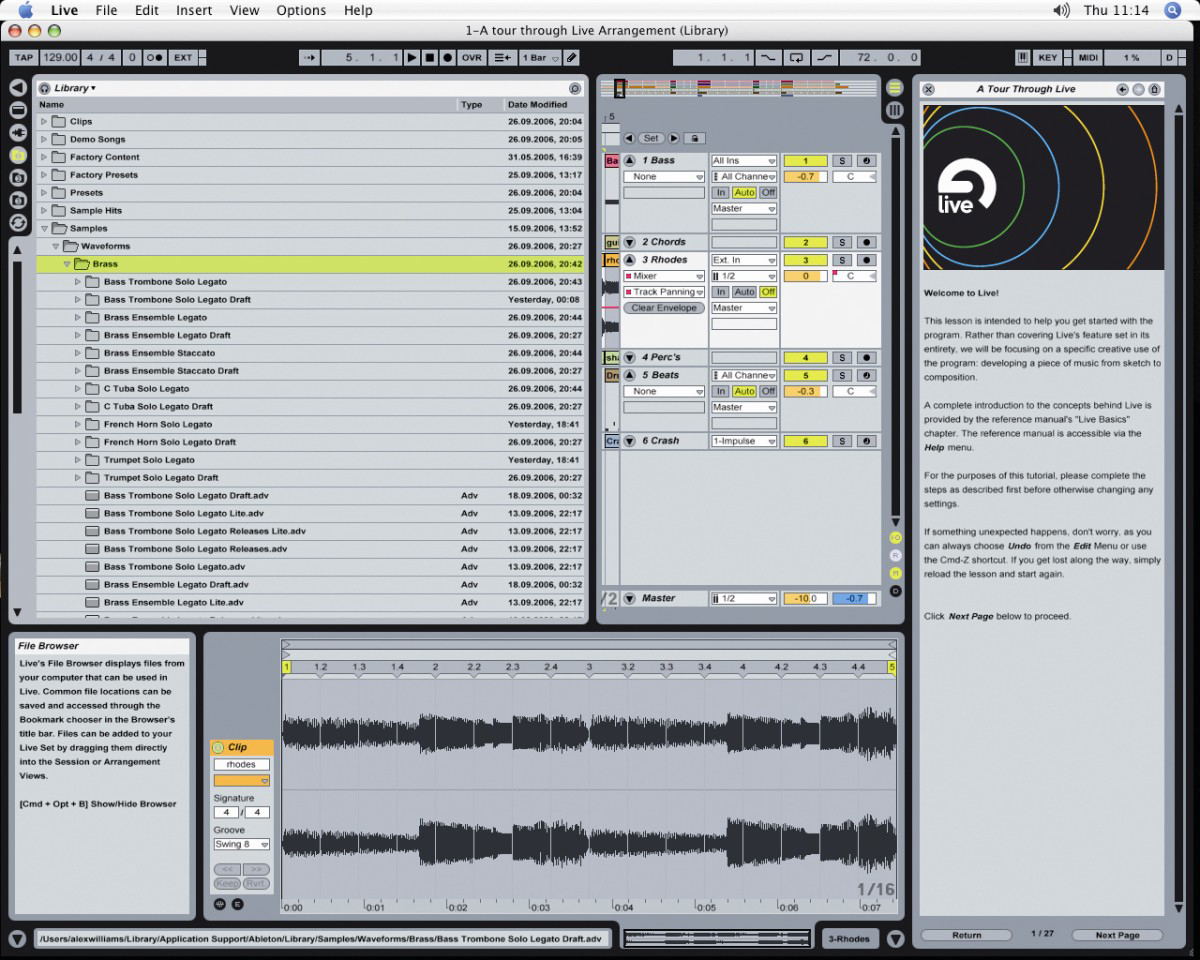MusicRadar Verdict
Inspiring, comprehensive and totally unique, Live 6 has the power to change the way you approach your music making. If you don´t give it a try, you´ll be missing out.
Pros
- +
Multicore support. Video playback. Stunning freeze functions. Tempo Master Clip in the Arrangement view. Very stable. Device Racks are hugely creative.
Cons
- -
Still no scissors tool. No sidechaining. No Tempo Master or multi-clip view in the Session view.
MusicRadar's got your back




The first thing you notice about Live 6 is the shiny new fascia. Every major Live upgrade brings a slightly tweaked interface, though if you don´t like version 6´s default look, you can choose from an array of other colour schemes (including the ones from all the previous versions´ interfaces).
One excellent visual touch is that almost every numerical readout - be it the cutoff of a filter or the plug-in buffer setting in the Preferences dialog - now sports a coloured bar that also represents its value. This makes it far easier to take in settings at a glance.
Another radical interface change relates to the level faders. These can now be stretched to about three times their original length, making mixing far more accurate; and each one also features a joint peak level/overload indicator. In the Arrangement view, you can now hide various mixing parameters to save on screen space.
Live 6 is far more than a collection of visual tweaks, though. Arguably the most useful improvement resides under the bonnet: the ability to address multiple cores and processors. Previously, Live made a bit of a meal of dealing with plug-ins from a CPU-load standpoint, and could only handle a moderate number of simultaneous effects and instruments.
This has all changed, however - Live 5 projects that any machine would struggle to cope with can now be handled with ease in Live 6 without the need for freezing. We´re talking major boosts in plug-in counts here - around 35-45% in our tests.
Too cool
Which brings us to Deep Freeze. This new system enables more flexible editing of frozen material than ever before. You can now drag frozen clips from the Session view and drop them right into the Arrangement view, or trigger frozen clips from the Session view and record your live arrangement.
Want all the hottest music and gear news, reviews, deals, features and more, direct to your inbox? Sign up here.
Unlike in the previous version, the new arrangement requires no further freezing for it to be played back. Frozen clips can even be moved or copied to new Scenes within the Session view, and you can drag frozen MIDI clips into audio tracks.
If that´s too troublesome, you can use the Flatten function to convert an entire track into audio, automatically stripping away all the original plug-ins. It´s also worth noting that the mechanics of the freezing process have been tweaked since Live 5, so there are now no clicks at loop points.
Elsewhere, fans of Live´s warping technology (ie, everyone) will be pleased to learn that you can now warp multiple clips in the Arrangement view simultaneously, so it´s possible to warp a multitrack project to the same settings in one go.
Also new to the Arrangement view are Tempo Master Clips. These finally endow Live with the ability to handle audio material that contains tempo changes by enabling a clip to dictate Live´s master tempo. For best results, you still need to carefully tweak the Warp Markers in the areas where the tempo changes, but it´s still a huge leap forward that makes creating DJ mixes for radio and compilations much easier.
Gratuitous plugs
Live 6 features three new plug-ins, the most enticing of which is a rather large, tasty distortion plug-in called Dynamic Tube. This offers three noticeably different characters of saturation and distortion, and it sounds the business (though not exactly analogue!). It´s versatile, too - you can throw it over pretty much anything in your mix.
Then there´s EQ Eight, which is far more than a rehash of EQ Four. Yes, it offers all of the same functionality plus, of course, four more bands, but it also features independent left/right controls and a mid/side mode (almost nobody will understand what this is for, but we can all sleep happier knowing that it´s in there).
Finally, there´s the Note Length MIDI plug-in. This might sound like it should be rather dull, but it´s actually very cool when placed in front of your soft synths in a device chain.
Mention of device chains brings us to another of Live 6´s key new features: the Device Rack system. This enables limitless grouping of plug-in effects and instruments, MIDI effects and even other Device Racks (think Reason´s Combinator and you´ll have a good idea of how Device Racks work).
You can layer multiple chains within one Rack and even set up keyzones to control how each chain is triggered. Keeping everything in order are eight freely (and multi-target) assignable front panel knobs.
The final major addition is movie playback support. Any Live users who are involved in post-production will relish the prospect of being able to edit and warp audio to match on-screen video, and this feature makes it much easier to sample sections from movie soundtracks.
It´s still basic, though - video playback is only available in the Arrangement view (though movies are available as audio clips in the Session view) and though you can warp video clips, you can´t export the resulting video.
This being the case, it´s not advisable to use this feature unless you want your video and sound to be out of sync! Still, we´re guessing Live´s video functionality will improve in time - what´s here now offers a tantalising glimpse of what VJs can expect in the future.
DJ dilemmas
So far so good, then, but Live 6 isn´t perfect. We´ve already mentioned the new Tempo Master Clips, but unfortunately, these are no good for DJs who need to be able to play back tracks that contain tempo changes in the Session view. Ableton say that to implement this feature would require a lot of work (they had to prioritise heavily when putting Live 6´s feature set together) but the fact remains that this is a big limitation if you´re a DJ. Another oversight from a DJ´s perspective is that there´s still no facility to view the waveforms of more than one clip at a time in the Session view. This means that there´s no way of spotting imminent breakdowns and drops. Could we not view waveforms in the window that currently shows us ‘time remaining´?
Then there´s the quality of the mixing. It´s a subjective issue, and while some users claim that Live doesn´t handle audio summing as well as other sequencers do, various unofficial tests have shown that non-warped audio is treated identically in all DAWs, as you´d expect. What´s certainly true (to our ears at least) is that Live can have a distinctive sound, and this might well be a result of its warping. Unfortunately, any signal that´s timestretched is always going to sound slightly different to one that isn´t.
Elsewhere, a definite omission is the lack of true sidechaining. Sidechained ducking and gating are two of the most used effects in modern dance music, but you can´t use them in Live.
Finally, there´s the ongoing (and still baffling) lack of a conventional toolbox in the Arrangement view. Even just a pair of virtual scissors would be nice, guys, and we´re not going to stop asking for them!
Six makes sense
In the end, though, we´re pleased to be able to say that Ableton have created another winner. As well as the major new features mentioned, there are countless other refinements: crossfader response curves; vastly improved file management systems; a huge array of MIDI controller presets (and improved learn functions); pre- or post-effects signal routing; assignment of multiple parameters to a single controller or key; tweaked ReWire functionality; rendering of individual tracks instead of just the complete mix; and resizing of multiple clips simultaneously in the Arrangement view.
Sure, you might argue that some of these features should already have been there, but the fact that Live was built from the ground up as an entirely original concept means it could be described as still in its primary development stage. The software´s total lack of legacy features means that every new addition, however small, is potentially very useful to most users if they take the trouble to learn it, and this ensures that Live is one of the most ergonomic, easy to use, stable and downright inspirational bits of software available.
We don´t want to sound too evangelical, but you could make a strong case for saying that Live is a ‘must have´ product for any creative musician, and version 6 lifts it to an entirely new level of maturity. If you aren´t yet using it, you really are all out of excuses, and if you own any previous version, upgrading is an undeniable necessity.
MusicRadar is the number 1 website for music makers of all kinds, be they guitarists, drummers, keyboard players, djs or producers...
GEAR: We help musicians find the best gear with top-ranking gear round-ups and high- quality, authoritative reviews by a wide team of highly experienced experts.
TIPS: We also provide tuition, from bite-sized tips to advanced work-outs and guidance from recognised musicians and stars.
STARS: We talk to musicians and stars about their creative processes, and the nuts and bolts of their gear and technique. We give fans an insight into the actual craft of music making that no other music website can.
